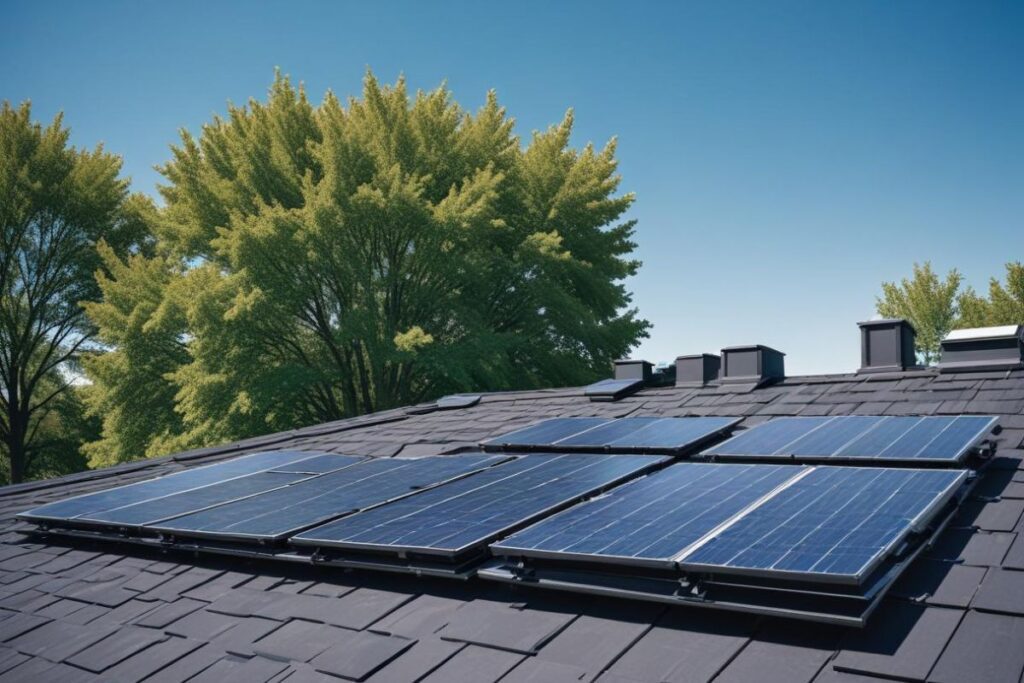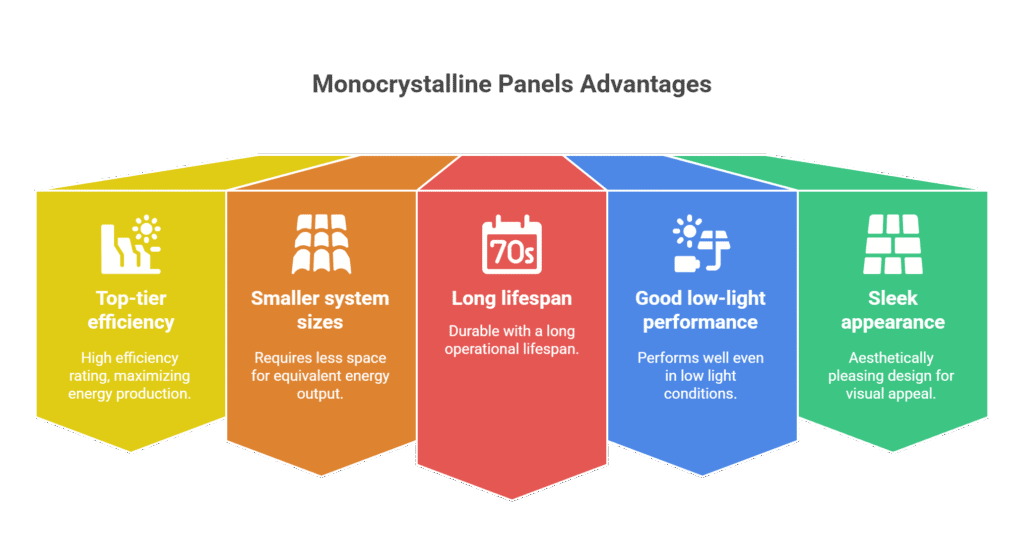You’re here because someone said monocrystalline panels are the “best” for solar, and maybe they are. But “best” depends on a bunch of stuff most people don’t think about. Roof size, power needs, long-term plans, shade, budget, it’s all connected. Let’s break down what matters. From someone who installs this stuff. In real homes. Right here in Milwaukee and Waukesha County.

What Are Monocrystalline Panels?
Monocrystalline solar panels are made from a single, pure crystal of silicon. That one piece of silicon is sliced into wafers, processed, and turned into the black panels you’ve probably seen on roofs all over, sleek, all-black, kind of high-end looking.
Now, here’s the key thing: they’re efficient. They convert sunlight into electricity more efficiently than cheaper options, such as polycrystalline panels (the blue-ish ones you might’ve seen).
So, if you’ve got limited roof space or higher electricity usage, or if you’re planning for things like EV charging or battery storage, monocrystalline is probably the right move.
Why Does It Matter to You?
Because solar isn’t pocket change. You’re probably looking at $15,000 to $30,000 for a complete system on a three-bedroom home, depending on usage, roof layout, electrical needs, and add-ons like battery backup.
If you’re already spending that kind of money, you want panels that’ll deliver as much energy as possible and keep doing it for 25+ years. Mono panels offer higher efficiency per square foot, which means more output, better long-term savings, and fewer panels needed for the same power.
Less roof used. More energy gained. Less wasted investment.
Pros of Monocrystalline Panels (Based on What We See)

- Top-tier efficiency: (usually 18–22%)
- Smaller system sizes: for the same energy, great if your roof is tight
- Long lifespan: 25 years is standard, but we’ve seen 30+
- Good low-light performance: which is important in Wisconsin, where clouds and snow aren’t exactly rare
- Sleek appearance: (to some people, that matters, and that’s fine)
At Lehmann Electrical, we almost always lean toward monocrystalline when the goal is long-term savings or max performance per square foot. We’re not guessing, we’re doing this every week.
The Downsides (There Are Some)
- They cost more upfront. If you’re comparing bottom-line pricing from some national solar company trying to close a sale in 10 minutes, they’ll usually pitch lower-end poly panels to hit that lower quote. It’s not a huge jump, but it’s there.
- They’re more sensitive to bad installation work. These panels are precise and high-output. If your installer cuts corners, messes up the wiring, or sizes things wrong, you lose the benefits real fast.
- Waste of money if the system isn’t matched to your usage. If your installer doesn’t look at your actual electric bill, roof orientation, or potential shade from trees, those “high efficiency” panels won’t perform as they should.
Mistakes We See Too Often
Here are the things that lead to disappointment, based on real jobs we’ve had to fix:
- People buy based on marketing, not facts. Some companies sell mono panels like they’re magic. They’re not. They’re good, but not if the rest of your system is mismatched or badly installed.
- Ignoring roof condition. Nobody wants to re-roof 5 years after solar install. We always check your roof first. If it needs work, we’ll tell you before we start.
- Overbuilding or underbuilding the system. We’ve seen both. You don’t need 40 panels if you only use 600 kWh/month. You also don’t want to install 10 panels and run out of room when you buy an EV two years later.
- Not thinking about future upgrades. If you plan to add battery backup or an EV charger later, we need to factor that in now, not patch it on later.
What Happens If It’s Done Wrong?
You waste money. Either by overpaying for stuff you don’t need, or by losing efficiency over time because the system isn’t set up right. Worst case, you void your warranty or have to rip things off and redo them. We’ve done tear-offs and re-installs because of bad work from out-of-state companies.
Most of those “bad installs” were done with monocrystalline panels. So again, panels don’t matter as much if the system is wrong.
What We Do Differently at Lehmann
We’re electricians first, not just solar salespeople. We understand everything behind the drywall, in the attic, and on your roof. We check your service panel, your roof age, your past electric usage, your future energy goals, and then we design a custom solar system for your home.
Everything is done in-house by our 15-person team. No subcontractors. No rushed installs. Just local professionals who care about getting it right the first time. And we’re available after the job’s done, because this is our home too.
We’ve helped dozens of families in Milwaukee, Wauwatosa, Brookfield, and beyond go solar installation the right way. Over 200 five-star reviews on Google. And we’re not stopping.
Bottom Line
Monocrystalline solar panels are a smart, high-performing option for most Milwaukee-area homeowners, but only if the full system is designed correctly. If your goal is long-term energy savings, cleaner power, and a setup you don’t have to worry about 5 years down the road, then yeah, we should talk.
Call us. Text us. Fill out the form. We’ll tell you straight what your home needs and what it doesn’t.
Q. Which is better, monocrystalline or polycrystalline?
Monocrystalline is more efficient because it has a very uniform look and is space-efficient. It is also available in a polycrystalline version that is less costly and less efficient. Go Mono if you want the best value in the long term.
Q. Are Tesla panels monocrystalline?
Yes, Tesla uses monocrystalline panels for better efficiency and a “sleek black” look.
Q. Are monocrystalline panels worth the extra cost?
Yes, especially if you’re looking for more power in less space or better performance in low light.
Q. How long do monocrystalline panels last?
The majority last 25–30 years or more with good installation and maintenance.
Read our recent solar blogs & pro tips
How does the solar heating system work
How is solar heating used in households
Monthly bill for solar panels
Is Solar Energy A Good or Bad Thing to Buy
How Long Does Solar Installation Take
How Much Do Solar Panels Cost In Wisconsin
How Much Does 1 Solar Panel Cost
Residential solar panels cost
